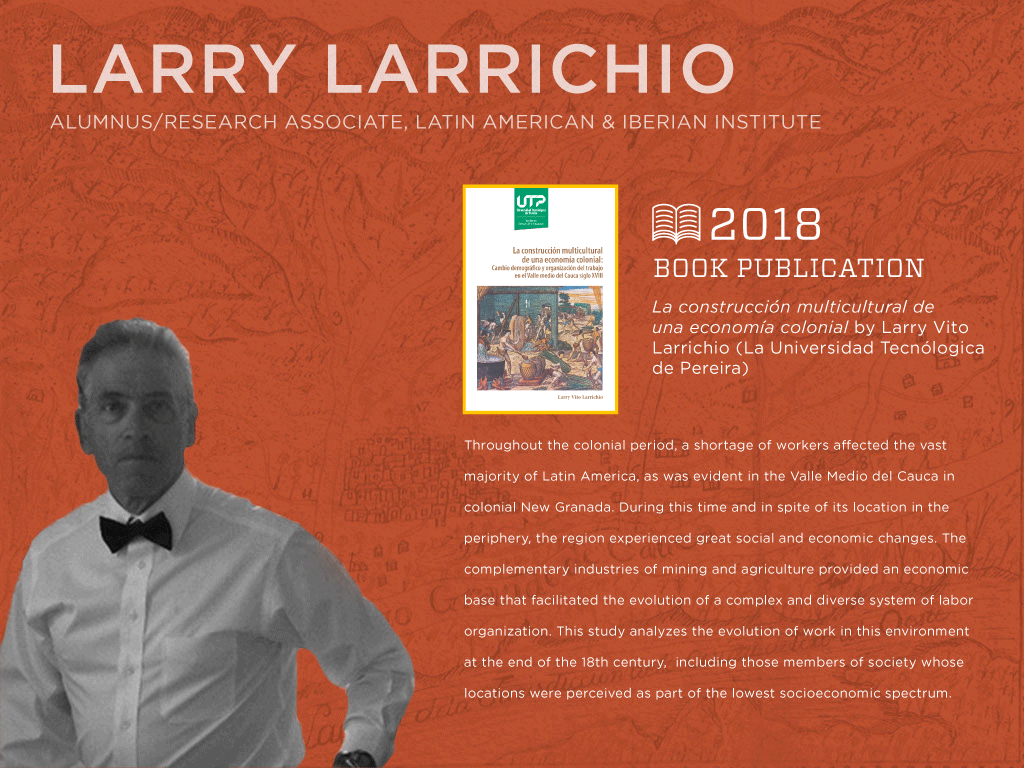Associate Researcher and Alum Larry Larrichio Publishes Book on Colonial Colombia
November 29, 2018

Dr. Larry Vito Larrichio, Research Associate and alumnus of the LAII, has released La construcción multicultural de una economía colonial.
Larrichio recently spoke at the 2018 Feria del Libro in Pereiro, Colombia, when the book was officially launched by its publisher, an academic press affiliated with La Universidad Tecnológica de Pereira, where he serves as a Visiting Professor. The book is the outcome of fieldwork Larrichio conducted for his dissertation. It was revised, translated into Spanish, and published in Colombia.
The book examines the history of how, throughout the colonial period, a shortage of workers affected most of Latin America, as was evident in the Middle Cauca Valley of colonial Colombia in the eighteenth century. Despite its location on the periphery of the Spanish Empire, the region experienced great social and economic changes. The complementary industries of mining and agriculture provided an economic base that facilitated the evolution of a complex and diverse system of labor organization. This study analyzes the contributions of a multicultural society within the framework of a changing workforce, including the contributions of those members of society that are usually perceived as part of the lowest socioeconomic spectrum.
As Larrichio explores in the text, Spaniards, Indians, and slaves had formal ties to the landed estates, which clearly defined their roles within the cultural and economic framework. Nevertheless, the majority of the valley’s population was composed of the ethnically mixed inhabitants on the margins of colonial society with no formal ties to land. These residents found wage labor opportunities primarily in the seasonal agricultural sector. Although many activities were driven by Spanish economic and commercial initiatives, slaves and Indians found opportunities for personal gain. Slaves earned supplementary income that improved their economic well-being, including the potential for manumission; Indians had a sufficient natural resource base, that provided sustainable agriculture and the potential to undertake a number of other profitable enterprises. Though small in number, the Indian community in the Middle Cauca region retained economic self-sufficiency and cultural identity; Spaniards found economic opportunities, and potential to reinvest resources to enhance their social status within colonial society; others, such as mestizo laborers, benefited as well through special land tenure arrangements with hacendados. The key to economic opportunity, and the potential to improve one’s place in society, was tied to formal affiliation with land via the essential industries of agriculture and mining.
The social, cultural, and economic milieu of the eighteenth-century Middle Cauca Valley was dynamic. This text offers an examination of the evolution of labor through the late eighteenth century, reflected in the wide range of opportunities for inhabitants of the region, including those groups that are usually perceived as being wedged at the bottom of the social-economic spectrum.
The book is available for review in the LAII Reading Room. Larrichio will discuss his research and findings as part of the Spring 2018 LAII Lecture Series.
